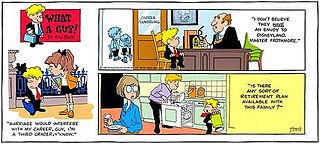
Miss Peach was a syndicated comic strip created by American cartoonist Mell Lazarus. It ran for 45 years, from February 4, 1957, to September 8, 2002.
Male Call is an American comic strip series created and drawn by Milton Caniff on a volunteer basis, exclusively for US military publications during World War II. The strip began January 24, 1943. Caniff continued Male Call until seven months after V-J Day, bringing it to a conclusion on March 3, 1946.

The Lockhorns is a United States single-panel cartoon created September 9, 1968 by Bill Hoest and originally distributed by King Features Syndicate to 500 newspapers in 23 countries. The Lockhorns joined Andrews McMeel Syndication (AMS) January 1, 2024 and continues to appear in hundreds of newspapers worldwide and online through websites including AMS's GoComics! After Hoest's death in 1988 the comic panel was continued by his wife Bunny Hoest and cartoonist John Reiner. In 2017 Hoest donated the archives of more than 37,000 of her cartoons - including The Lockhorns, Howard Huge and others - to Adelphi University where she obtained a Bachelor of Arts degree and an honorary doctorate.

Harold Teen is a discontinued, long-running American comic strip written and drawn by Carl Ed. Publisher Joseph Medill Patterson may have suggested and certainly approved the strip's concept, loosely based on Booth Tarkington's successful novel Seventeen. The strip ran from 1919 to 1959. Asked in the late 1930s why he had started the strip, Ed answered, "Twenty years ago, there was no comic strip on adolescence. I thought every well-balanced comic sheet should have one."

Smitty was a newspaper comic strip created in the early 1920s by Walter Berndt. Syndicated nationally by the Chicago Tribune New York News Syndicate, it ran from November 27, 1922, to 1974 and brought Berndt a Reuben Award in 1969.

William Pierce Hoest was an American cartoonist best known as the creator of the comic strip The Lockhorns, distributed by King Features Syndicate to 500 newspapers in 23 countries, and Laugh Parade for Parade. He also created other syndicated strips and panels for King Features. His wife Bunny Hoest succeeded him as writer for The Lockhorns after his death, continuing to this day.

Mr. Mystic is a comics series featuring a magician crime-fighter, created by Will Eisner and initially drawn by Bob Powell. The strip featured in four-page backup feature a Sunday-newspaper comic-book insert, known colloquially as "The Spirit Section". It first appeared in 1940, distributed by the Register and Tribune Syndicate.

Howard Post was an American animator, cartoonist, and comic strip and comic book writer-artist.

Little Jimmy, originally titled Jimmy, is a newspaper comic strip created by Jimmy Swinnerton. With a publication history from February 14, 1904, to April 27, 1958, it was one of the first continuing features and one of the longest running.

Aggie Mack was a newspaper comic strip about a teenage girl. Created by Hal Rasmusson, it was distributed by the Chicago Tribune Syndicate beginning on September 2, 1946, and concluding on January 9, 1972. It had a 26-year run, with a title change to Aggie during the final six years.

Agatha Crumm is a newspaper comic strip created by the cartoonist Bill Hoest and distributed by King Features Syndicate. The strip ran from October 24, 1977, until 1997. Agatha Crumm was Hoest's third strip, following Bumper Snickers (1974).

Etta Kett is a long-running comic strip created by Paul Robinson, which ran from December 7, 1925 to November 9, 1974.

Friday Foster is an American newspaper comic strip, created and written by Jim Lawrence and illustrated by Jorge Longarón. It ran from January 18, 1970, to February 17, 1974 and was notable for featuring one of the first African-American women as the title character in a comic strip. Jackie Ormes' Torchy Brown predated it, although it saw a more limited release in the Afro-American newspaper Pittsburgh Courier.

What a Guy! is an American comic strip created by Bill Hoest and Bunny Hoest, the team responsible for The Lockhorns and Agatha Crumm. It began in March 1987, just over a year before Hoest's death in 1988.
Little Joe is a 1933-1972 Western comic strip created by Ed Leffingwell and later continued by his brother Robert Leffingwell. Distributed by the Chicago Tribune Syndicate, this Sunday strip had a long run spanning four decades. It was never a daily strip.

Teena is a comic strip about a teenage girl, created by Hilda Terry. It ran from July 1, 1944, to 1963, distributed by King Features Syndicate.

Harry William Haenigsen was an American illustrator and cartoonist best known for Penny, his comic strip about a teenage girl. He also illustrated for books, magazines and advertising.

Hal Rasmusson was an American cartoonist best known for the comic strip Aggie Mack, about a teenage girl.

Sol Hess was a comic strip writer best known for creating the long-run strip The Nebbs with animation artist Wallace Carlson.
The New York Herald Tribune Syndicate was the syndication service of the New York Herald Tribune. Syndicating comic strips and newspaper columns, it operated from c. 1914 to 1966. The syndicate's most notable strips were Mr. and Mrs., Our Bill, Penny, Miss Peach, and B.C. Syndicated columns included Walter Lippmann's Today and Tomorrow, Weare Holbrook's Soundings, George Fielding Eliot's military affairs column, and John Crosby's radio and television column. Irita Bradford Van Doren was book review editor for a time.

















